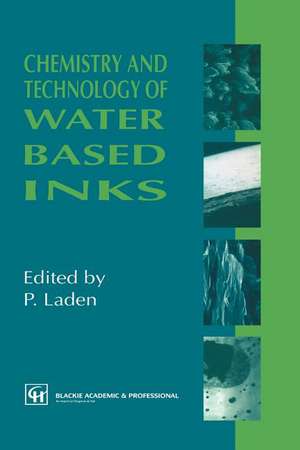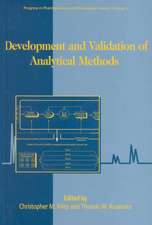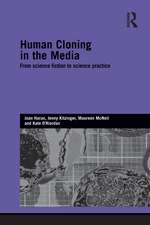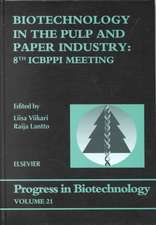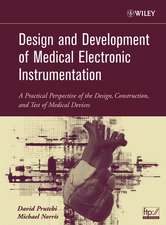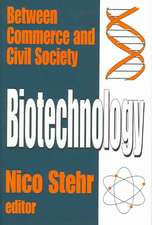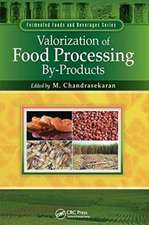Chemistry and Technology of Water Based Inks
Editat de P. Ladenen Limba Engleză Paperback – 20 sep 2011
| Toate formatele și edițiile | Preț | Express |
|---|---|---|
| Paperback (1) | 1818.96 lei 6-8 săpt. | |
| SPRINGER NETHERLANDS – 20 sep 2011 | 1818.96 lei 6-8 săpt. | |
| Hardback (1) | 1825.27 lei 6-8 săpt. | |
| SPRINGER NETHERLANDS – 31 dec 1996 | 1825.27 lei 6-8 săpt. |
Preț: 1818.96 lei
Preț vechi: 2218.24 lei
-18% Nou
Puncte Express: 2728
Preț estimativ în valută:
348.05€ • 364.37$ • 287.99£
348.05€ • 364.37$ • 287.99£
Carte tipărită la comandă
Livrare economică 05-19 aprilie
Preluare comenzi: 021 569.72.76
Specificații
ISBN-13: 9789401071901
ISBN-10: 940107190X
Pagini: 364
Ilustrații: XIV, 346 p.
Dimensiuni: 155 x 235 x 19 mm
Greutate: 0.51 kg
Ediția:1997
Editura: SPRINGER NETHERLANDS
Colecția Springer
Locul publicării:Dordrecht, Netherlands
ISBN-10: 940107190X
Pagini: 364
Ilustrații: XIV, 346 p.
Dimensiuni: 155 x 235 x 19 mm
Greutate: 0.51 kg
Ediția:1997
Editura: SPRINGER NETHERLANDS
Colecția Springer
Locul publicării:Dordrecht, Netherlands
Public țintă
ResearchCuprins
1 Introduction.- 1.1 Environmental considerations for water based inks.- 1.2 Factors affecting the change to water based inks.- 2 Colorimetry and the calculation of color difference.- 2.1 Introduction.- 2.2 Elements needed to describe color.- 2.3 The CIE system.- 2.4 Applications of the 1976 CIE L*a*b* formula for the calculation of color tolerances.- 2.5 Calculations: detailed example.- 2.6 CIELAB color difference equations.- References.- 3 Flexographic printing presses.- 3.1 Introduction.- 3.2 Evolution of flexo-type litho.- 3.3 Testing incoming inks.- 3.4 Viscosity as a measurement to make production flow.- 3.5 A unit that enables variable control of ink density and thickness.- 3.6 Drying of inks.- 3.7 Evaluation of anilox rolls.- 3.8 The reverse-angle doctor blade and anilox rolls.- 3.9 How the reverse-angle doctor blade works, and a comparison with other metering systems.- 3.10 Advantages and disadvantages of the reverse-angle anilox blade.- 3.11 Overcoming moire effects in flexography.- 3.12 Drying power of inks.- 3.13 Variations in thickness of substrates.- 3.14 Flexographic printing on corrugated board.- 4 Pigments.- 4.1 Pigments for printing inks.- 4.2 Classification of pigments.- 4.3 Pigment composition.- 4.4 Manufacture of azo pigments.- 4.5 Pigments produced from crudes.- 4.6 Advantages and disadvantages of dry pigments in a water based system.- 4.7 Handling dry pigments.- 4.8 Marketplace analysis for dry pigments.- 4.9 Water based pigment dispersions.- 4.10 Pigment structures.- References.- 5 Carbon black.- 5.1 Classification and types of carbon black.- 5.2 Composition of carbon black.- 5.3 Manufacture of carbon black.- 5.4 Properties and testing methods of carbon black.- 5.5 Applications of carbon black.- References.- Solvents.- 6.1 Introduction.- 6.2 Glycol ether solvents for water based ink applications.- 7 Emulsion and solution polymers.- 7.1 Designing innovative water based polymers for graphic arts.- 7.2 Reduction of volatile organic compounds through aqueous acrylic polymers.- 7.3 The waterborne way.- 8 Additives.- 8.1 Hyperdispersants: the problem solvers.- 8.2 Defoaming agents.- References.- 9 Design and formulation of water based ink systems.- 9.1 Factors to be considered when designing a water based ink system.- 9.2 Scratch-off inks and coatings.- Appendix 9.A: data for design and formulation.- 10 Particle size reduction of pigments using a small media mill.- 10.1 Introduction.- 10.2 Machine design.- 10.3 Machine operation.- 10.4 Controlling factors in milling.- 10.5 Mill design.- 10.6 Agitation systems.- 10.7 Applications.- 10.8 Conclusions.- References.- 11 Dispersion of low viscosity water based inks.- 11.1 Introduction.- 11.2 Background.- 11.3 Major dispersion steps.- 11.4 Dispersion equipment design.- 11.5 Choosing a dispersion line.- 11.6 One-step processes.- 11.7 Multiple step processes (final media milling).- 11.8 Summary.- References.- Appendices.- Appendix A: Trouble-shooting guide.- 1 Manufacturing.- 2 Flexographic packaging printing.- 3 Packaging, gravure printing.- 4 Viscosity conversion guide.- 5 Ink mileage estimation.- 6 Viscosity (poise).- Appendix B: Typical starting formulations for water based inks.- 1 Generalinks.- 2 Flexo/gravure inks.- 3 Flexo/roto inks.- Appendix C: Trademarked raw materials for typical water based inks.- Appendix D: Addresses of US suppliers of materials used in water basedinks.
